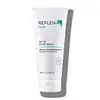What's inside
What's inside
 Key Ingredients
Key Ingredients

 Benefits
Benefits

 Concerns
Concerns

 Ingredients Side-by-side
Ingredients Side-by-side

Water
Skin ConditioningCocamidopropyl Betaine
CleansingSodium C14-16 Olefin Sulfonate
CleansingPalmitic Acid
EmollientHydroxypropyl Starch Phosphate
Glycerin
HumectantStearic Acid
CleansingVitis Vinifera Seed Oil
EmollientSodium Hydroxide
BufferingPhenoxyethanol
PreservativeCaprylyl Glycol
EmollientSodium Sulfate
C10-16 Olefin
Sodium Chloride
MaskingTocopheryl Acetate
AntioxidantLeuconostoc/Radish Root Ferment Filtrate
AntimicrobialHyaluronic Acid
HumectantHibiscus Sabdariffa Flower Extract
Skin ConditioningYeast Extract
Skin ConditioningPapain
Skin ConditioningSoy Amino Acids
Skin Conditioning1,2-Hexanediol
Skin ConditioningCarbomer
Emulsion StabilisingPotassium Sorbate
PreservativeSodium Benzoate
MaskingAlgin
MaskingWater, Cocamidopropyl Betaine, Sodium C14-16 Olefin Sulfonate, Palmitic Acid, Hydroxypropyl Starch Phosphate, Glycerin, Stearic Acid, Vitis Vinifera Seed Oil, Sodium Hydroxide, Phenoxyethanol, Caprylyl Glycol, Sodium Sulfate, C10-16 Olefin, Sodium Chloride, Tocopheryl Acetate, Leuconostoc/Radish Root Ferment Filtrate, Hyaluronic Acid, Hibiscus Sabdariffa Flower Extract, Yeast Extract, Papain, Soy Amino Acids, 1,2-Hexanediol, Carbomer, Potassium Sorbate, Sodium Benzoate, Algin
Ingredients Explained
These ingredients are found in both products.
Ingredients higher up in an ingredient list are typically present in a larger amount.
Carbomer is a polymer of acrylic acid. Its main role is to create a gel consistency.
A high amount of carbomer can cause pilling or balling up of products. Don't worry, most products contain 1% or less of carbomer.
Phenoxyethanol is a preservative that has germicide, antimicrobial, and aromatic properties. Studies show that phenoxyethanol can prevent microbial growth. By itself, it has a scent that is similar to that of a rose.
It's often used in formulations along with Caprylyl Glycol to preserve the shelf life of products.
Sodium Benzoate is a preservative. It's used in both cosmetic and food products to inhibit the growth of mold and bacteria. It is typically produced synthetically.
Both the US FDA and EU Health Committee have approved the use of sodium benzoate. In the US, levels of 0.1% (of the total product) are allowed.
Sodium benzoate works as a preservative by inhibiting the growth of bacteria inside of cells. It prevents the cell from fermenting a type of sugar using an enzyme called phosphofructokinase.
It is the salt of benzoic acid. Foods containing sodium benzoate include soda, salad dressings, condiments, fruit juices, wines, and snack foods.
Studies for using ascorbic acid and sodium benzoate in cosmetics are lacking, especially in skincare routines with multiple steps.
We always recommend speaking with a professional, such as a dermatologist, if you have any concerns.
Learn more about Sodium BenzoateSodium C14-16 Olefin Sulfonate is a cleansing agent made from a mixture of long chain sulfonate salts. It can also help produce foam.
This ingredient may be drying. We recommend speaking with a professional if you have concerns.
Stearic Acid is a fatty acid. It is an emollient, emulsifier, and texture enhancer.
As an emollient, stearic acid helps soften skin. It aids the skin's protective barrier by preventing water loss. It also provides a gentle cleansing effect without stripping away natural oils.
Stearic acid may also be used to enhance the texture of products. It can add volume and stabilize ingredients such as water and oil. This can help water and oil ingredients from separating.
Sources of stearic acid include animal or vegetable fats/oils such as coconut or shea. It can be naturally found in butter, cocoa butter, shea butter, vegetable fats, and animal tallow.
This ingredient may not be Malassezia folliculitis, or fungal-acne safe.
Learn more about Stearic AcidWater. It's the most common cosmetic ingredient of all. You'll usually see it at the top of ingredient lists, meaning that it makes up the largest part of the product.
So why is it so popular? Water most often acts as a solvent - this means that it helps dissolve other ingredients into the formulation.
You'll also recognize water as that liquid we all need to stay alive. If you see this, drink a glass of water. Stay hydrated!
Learn more about Water